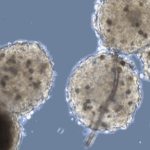
With the help of a 3D printer, mini human organs can come in all shapes and sizes. In this video, a cluster of tiny hearts – shown on the right – beat in sync, and another pulsing heart is fused with a spherical, darker-coloured liver.
Developed by Anthony Atala and his team at the Wake Forest Institute for Regenerative Medicine in Winston-Salem, North Carolina, the mini-organs represent the first step in developing an entire human body on a chip.
The hearts were created by reprogramming human skin cells into heart cells, which were then clumped together in a cell culture. A 3D printer was then used to give them the desired shape and size – in this case, a diameter of 0.25 millimetres.
The scaled-down organs are being developed to mimic the function of their life-size counterparts. Eventually, they could be linked up to form an entire organ system that could be used to test new treatments or probe the effects of chemicals and viruses.
The approach is being developed as an alternative to animal testing, which is costly and doesn’t always produce results that are applicable to humans.
Source: Www.newscientist.com